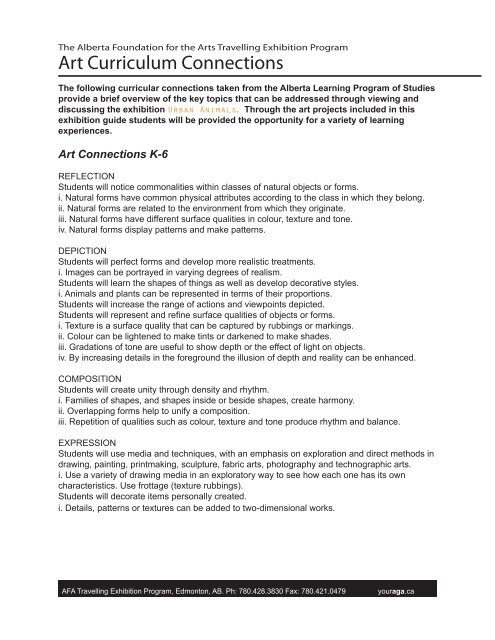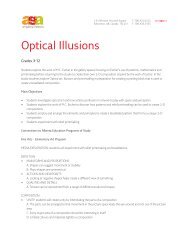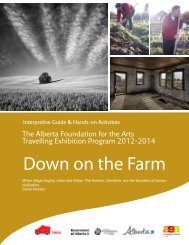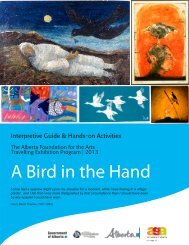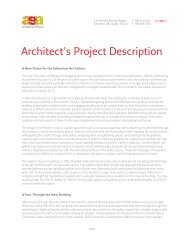Urban Animals - Art Gallery of Alberta
Urban Animals - Art Gallery of Alberta
Urban Animals - Art Gallery of Alberta
You also want an ePaper? Increase the reach of your titles
YUMPU automatically turns print PDFs into web optimized ePapers that Google loves.
The <strong>Alberta</strong> Foundation for the <strong>Art</strong>s Travelling Exhibition Program<br />
<strong>Art</strong> Curriculum Connections<br />
The following curricular connections taken from the <strong>Alberta</strong> Learning Program <strong>of</strong> Studies<br />
provide a brief overview <strong>of</strong> the key topics that can be addressed through viewing and<br />
discussing the exhibition <strong>Urban</strong> <strong>Animals</strong>. Through the art projects included in this<br />
exhibition guide students will be provided the opportunity for a variety <strong>of</strong> learning<br />
experiences.<br />
<strong>Art</strong> Connections K-6<br />
REFLECTION<br />
Students will notice commonalities within classes <strong>of</strong> natural objects or forms.<br />
i. Natural forms have common physical attributes according to the class in which they belong.<br />
ii. Natural forms are related to the environment from which they originate.<br />
iii. Natural forms have different surface qualities in colour, texture and tone.<br />
iv. Natural forms display patterns and make patterns.<br />
DEPICTION<br />
Students will perfect forms and develop more realistic treatments.<br />
i. Images can be portrayed in varying degrees <strong>of</strong> realism.<br />
Students will learn the shapes <strong>of</strong> things as well as develop decorative styles.<br />
i. <strong>Animals</strong> and plants can be represented in terms <strong>of</strong> their proportions.<br />
Students will increase the range <strong>of</strong> actions and viewpoints depicted.<br />
Students will represent and refine surface qualities <strong>of</strong> objects or forms.<br />
i. Texture is a surface quality that can be captured by rubbings or markings.<br />
ii. Colour can be lightened to make tints or darkened to make shades.<br />
iii. Gradations <strong>of</strong> tone are useful to show depth or the effect <strong>of</strong> light on objects.<br />
iv. By increasing details in the foreground the illusion <strong>of</strong> depth and reality can be enhanced.<br />
COMPOSITION<br />
Students will create unity through density and rhythm.<br />
i. Families <strong>of</strong> shapes, and shapes inside or beside shapes, create harmony.<br />
ii. Overlapping forms help to unify a composition.<br />
iii. Repetition <strong>of</strong> qualities such as colour, texture and tone produce rhythm and balance.<br />
EXPRESSION<br />
Students will use media and techniques, with an emphasis on exploration and direct methods in<br />
drawing, painting, printmaking, sculpture, fabric arts, photography and technographic arts.<br />
i. Use a variety <strong>of</strong> drawing media in an exploratory way to see how each one has its own<br />
characteristics. Use frottage (texture rubbings).<br />
Students will decorate items personally created.<br />
i. Details, patterns or textures can be added to two-dimensional works.<br />
AFA Travelling Exhibition Program, Edmonton, AB. Ph: 780.428.3830 Fax: 780.421.0479<br />
youraga.ca


